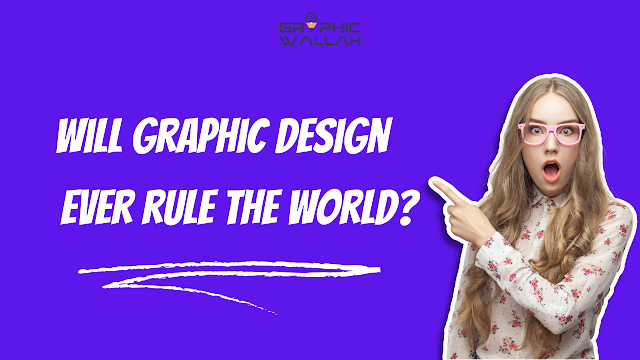Will graphic design ever rule the world? Exploring the Power and Influence of Visual Communication
Introduction:
In a world inundated with visual stimuli, graphic design plays a pivotal role in shaping perceptions, influencing decisions, and ultimately, driving the trajectory of societies. From advertising campaigns to political propaganda, from product packaging to user interface design, graphic design permeates every facet of modern life. But can it ever ascend to a position where it rules the world? Let's delve into this intriguing question, exploring the power, potential, and limitations of graphic design in shaping our collective consciousness.
The Evolution of Graphic Design:
Graphic design has a rich history dating back to ancient civilizations, where symbols and imagery were used to communicate ideas and concepts. Over time, it has evolved into a sophisticated discipline encompassing elements of art, psychology, technology, and communication. The invention of the printing press in the 15th century revolutionized the spread of information, giving rise to posters, newspapers, and other printed materials that relied heavily on graphic design principles.
Fast forward to the digital age, and graphic design has taken on new dimensions with the advent of computers, software applications, and the internet. Designers now have an unprecedented array of tools, allowing them to create immersive experiences across various mediums, from websites and mobile apps to virtual reality environments. This technological advancement has expanded the reach and impact of graphic design, enabling it to reach global audiences instantly.
The Power of Visual Communication:
At its core, graphic design is about communication—conveying messages, evoking emotions, and sparking action through visual means. It taps into the fundamental human propensity to process information visually, making it a potent tool for persuasion and influence. Consider the iconic imagery of political movements, such as the clenched fist of resistance or the vibrant revolution posters. These visuals have the power to galvanize the masses, instilling a sense of unity and purpose among diverse populations.
In the realm of advertising and branding, graphic design wields immense influence in shaping consumer behavior and brand perception. Logos, color schemes, and typography—all contribute to the formation of brand identities that resonate with target audiences. A well-crafted design can evoke trust, loyalty, and desire, driving consumer engagement and sales. In today's hyper-competitive marketplace, businesses recognize the pivotal role of design in differentiating their offerings and capturing market share.
Moreover, graphic design can transcend linguistic and cultural barriers, serving as a universal language that speaks to people across borders and demographics. This universality enables brands, movements, and ideas to transcend geographical constraints, fostering global connections and solidarity. From the iconic Apple logo to the peace symbol, certain designs have achieved iconic status, transcending their original contexts to become emblematic of broader ideals and aspirations.
Limitations and Ethical Considerations:
While graphic design possesses formidable influence, it is not without its limitations and ethical considerations. Design can be used for nefarious purposes, such as propaganda, manipulation, and misinformation. In the age of social media, where information spreads rapidly and unchecked, the power of design to shape public opinion can be both a blessing and a curse. Designers bear a responsibility to wield their craft ethically, ensuring that their work promotes truth, equity, and social good.
Furthermore, the democratization of design tools has led to a proliferation of amateur and untrained designers flooding the digital landscape with subpar and potentially harmful content. The prevalence of fake news, clickbait, and sensationalist imagery underscores the importance of media literacy and critical thinking in navigating today's visual landscape. As consumers, we must remain vigilant and discerning, questioning the motives behind the designs we encounter and seeking out reputable sources of information.
The Future of Graphic Design:
As we look to the future, the role of graphic design is poised to expand further, driven by technological advancements and shifting societal dynamics. Augmented reality, artificial intelligence, and immersive media are opening up new possibilities for interactive and experiential design. From virtual reality concerts to augmented reality shopping experiences, the boundaries between the physical and digital worlds are blurring, offering new avenues for creative expression and engagement.
Moreover, as pressing global challenges such as climate change, social inequality, and public health crises demand urgent attention, graphic design can catalyze positive change. Designers have the power to raise awareness, inspire action, and drive solutions to some of the most pressing issues facing humanity. Whether through environmental advocacy campaigns, social justice initiatives, or public health outreach efforts, graphic design can be a force for good in the world, amplifying voices and catalyzing collective action.
Conclusion:
In conclusion, while graphic design may not "rule" the world in the traditional sense, it undeniably exerts a profound influence on our perceptions, behaviors, and interactions. As a powerful tool of visual communication, design shapes our collective consciousness, driving cultural shifts, shaping consumer preferences, and fostering global connections. However, with great power comes great responsibility, and designers must wield their craft ethically and conscientiously, mindful of the impact their work has on individuals and society at large. Ultimately, the future of graphic design holds boundless potential to inspire, innovate, and effect positive change in the world.

Comments
Post a Comment